

Creative AI newsletter #8 - Auctions, continued hype and AI art overload □□ Ressources. Mario klingemann. Deep matter. Robbie barrat. Portrait of edmond belamy | obvious | robbie barrat. Claire malrieux. AI Artists Expose “Kinks” In Algorithmic Censorship — Artnome. For this series of images Klingemann is calling “eroGANous,” he intentionally evolved a generative adversarial network called “BigGAN” for “maximum NSFW-ness.”
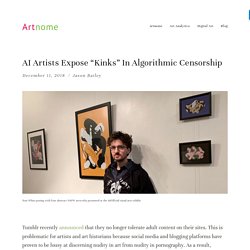
Klingemann points out, “Tumblr's filter is not happy about them, but it looks like they may still show for a few days.” The complete series can be seen here, for now. Klingemann sees the use of AI to broadly censor content as problematic as it results in “sterile” content. As he shared with me: EroGANous. How to recognize fake AI-generated images – Kyle McDonald. In 2014 machine learning researcher Ian Goodfellow introduced the idea of generative adversarial networks or GANs.
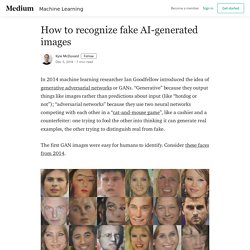
“Generative” because they output things like images rather than predictions about input (like “hotdog or not”); “adversarial networks” because they use two neural networks competing with each other in a “cat-and-mouse game”, like a cashier and a counterfeiter: one trying to fool the other into thinking it can generate real examples, the other trying to distinguish real from fake. The first GAN images were easy for humans to identify. Consider these faces from 2014. But the latest examples of GAN-generated faces, published in October 2017, are more difficult to identify.
Here are some things you can look for when trying to recognize an image produced by a GAN. Straight hair looks like paint Text is indecipherable GANs trained on faces have a hard time capturing rare things in the background with lots of structure. 8 AI Designers You Need To Know – Forbes. Top AI Designers you need to know Advances in the field of artificial intelligence may be easy to trace, but mapping out emerging implications, risks, use cases, and opportunities can easily short-circuit anyone’s brain.
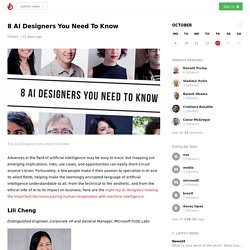
Fortunately, a few people make it their passion to specialize in AI and its allied fields, helping make the seemingly encrypted language of artificial intelligence understandable to all. From the technical to the aesthetic, and from the ethical side of AI to its impact on business, here are the eight top AI designers making the important decisions pairing human imagination with machine intelligence. Lili Cheng Distinguished Engineer, Corporate VP and General Manager, Microsoft FUSE Labs Lili Cheng Douglas Eck Research Scientist at Google Brain, leading the Magenta project. Generative art. When you can produce an image or an effect with the push of a button, it usually gets old quick.
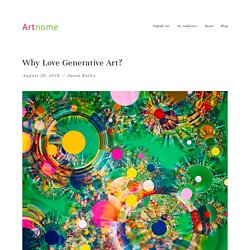
So it is not hard to imagine that we will see something akin to the tsunami of images with Photoshop filters we were inundated with in the early ‘90s. In fact, Valenzuela is building a tool suite not unlike Photoshop, but leveraging AI to democratize the new tools for artists and designers. Alt-AI — Artists and Machine Intelligence. Alt-AI I recently attended #alt-ai, a mini conference on Art and MI organized by Gene Kogan, Lauren Gardner, and folks at the School for Poetic Computation (sfpc) in New York City.
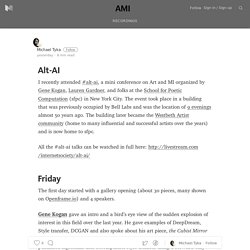
The event took place in a building that was previously occupied by Bell Labs and was the location of 9 evenings almost 50 years ago. The building later became the Westbeth Artist community (home to many influential and successful artists over the years) and is now home to sfpc. Deep Dream - Online Generator. DeepDream - a code example for visualizing Neural Networks. Posted by Alexander Mordvintsev, Software Engineer, Christopher Olah, Software Engineering Intern and Mike Tyka, Software Engineer Two weeks ago we blogged about a visualization tool designed to help us understand how neural networks work and what each layer has learned.
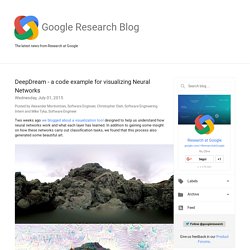
In addition to gaining some insight on how these networks carry out classification tasks, we found that this process also generated some beautiful art. We have seen a lot of interest and received some great questions, from programmers and artists alike, about the details of how these visualizations are made. We have decided to open source the code we used to generate these images in an IPython notebook, so now you can make neural network inspired images yourself! The code is based on Caffe and uses available open source packages, and is designed to have as few dependencies as possible. Google is working on a project that will test the artistic ability of AI.
Google is working on a new project to determine if artificial intelligence can ever be truly creative.
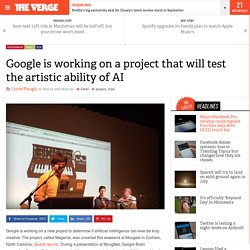
The project, called Magenta, was unveiled this weekend at Moogest in Durham, North Carolina, Quartz reports. During a presentation at Moogfest, Google Brain researcher Douglas Eck said the goal of the new group is to determine if AI is capable of creating original music and visual art somewhat independently of humans. Can AI be creative? The Magenta team will use Google's open-source machine learning software TensorFlow, and try to "train" AI to make art. They'll create tools (and make them available to the public), like one that helps researchers import data from MIDI files into TensorFlow, Quartz reports. A member of the Magenta team, Adam Roberts, demoed a digital synth program that could make music after listening to notes played by a human. The idea itself — that AI can be used to create art — is not new. Magenta will publicly launch at the start of June, Quartz reports. Alt-AI. Machine Learning for Artists.